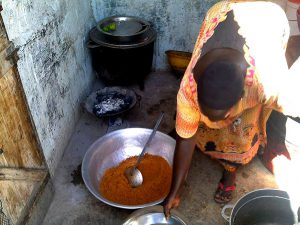[hr]
By Folakunle Oshun
[hr]
30 October 2015
It was the first day of the road trip from Lagos to Saint-Louis, Senegal. I was journeying to explore the migratory and ownership controversies surrounding the popular West African dish, Jollof rice, as part of the research for my project, Wolof/Jollof. I wanted to get the facts right so as to put an end to the Jollof wars that had Nigerians and Ghanaians constantly at each other’s throats.
The debate on which one of these nations has the best Jollof rice has been trending online for close to five years, if not more. Each country claims ownership. The truth is somewhere in between. Jollof is a pidgin word for the Wolof people of Senegal and the earliest recipes were formulated in Senegal. But even this becomes slippery in a global world. Brazil, for example, has a red rice which looks and almost tastes like Jollof. In Nigeria, the very idea that anyone else makes better Jollof is taboo. It’s become a national dish and inspires fierce emotions that extend beyond the kitchen. Jollof is good feeling. It’s the joy you feel at a wedding when its spicy aroma fills the air. It is that one dish across the country that no one ever objects to. In a country of two hundred ethnic groups, more than one thousand indigenous dishes and more tastes, it suggests unity.
But to understand the roots of its unifying power, I had to cross borders. First, all 20 checkpoints within a 200m span of the infamous Seme border between Lagos and Cotonou. Once this ritual was over, I proceeded to change my currency from Naira to CFA Franc, which is the accepted currency in most francophone African states. This in itself was another ritual as the rates keep fluctuating, not to mention that the money-changers are also very aware! All professed to be honest. I knew I was being cheated blindly but was happy to be on my way. I was put on a commercial motorbike to take me about 20km into Cotonou, where I would get a bus to Bamako in Mali.
I eventually got to the bus park and waited about five hours to get on a bus that was initially billed to leave in about 30 minutes. Luckily, I met a familiar face in the park, Ben Chislet, a photographer from Berlin who had been a part of the just concluded Lagos Photo Festival. He was on his way to see the photo biennale in Bamako, so we decided to ride together since Bamako was along my way. We bonded quickly and shared our fears on the deadly journey that was ahead of us. The best part was that I had someone to take photographs of my quest for Jollof. We were soon to find out that rice came at a price and most of these images had to be stolen. Ben, who was also familiar with the Jollof phenomenon, was keen to see if anything would beat the Lagos Jollof he had become acquainted with. He loaded his bag with biscuits and water; I, on the other hand, was ready to eat whatever came my way, hoping I had a tougher stomach. I was wrong.
31 October 2015
 At about a few minutes to midnight, our bus finally left Cotonou. Morning came slowly and our hopes of some respite were dashed as the bus kept going until about 4pm, when we had our very first stop. Deep into the north of Benin Republic, a vast expanse of arid land with tiny pockets of civilisation, we managed to catch some food and fresh air. It was quite surprising that the only two people on the bus complaining about the harsh travel conditions were Ben and I. To crown my frustrations, I hadn’t seen or tasted a grain of Jollof rice since my trip began.
At about a few minutes to midnight, our bus finally left Cotonou. Morning came slowly and our hopes of some respite were dashed as the bus kept going until about 4pm, when we had our very first stop. Deep into the north of Benin Republic, a vast expanse of arid land with tiny pockets of civilisation, we managed to catch some food and fresh air. It was quite surprising that the only two people on the bus complaining about the harsh travel conditions were Ben and I. To crown my frustrations, I hadn’t seen or tasted a grain of Jollof rice since my trip began.
My first taste of anything close to Jollof rice came right as we got into Burkina Faso. The taste wasn’t anything familiar, but it kept me alive. I was less than impressed with this coloured rice which I later learnt was called malo. More unimpressive was the racket which was run by the border officials. By our summations, they deliberately kept us at the checkpoints so we could buy food from the vendors. This wasn’t the Jollof trip I had in mind, where I was sampling different recipes of Jollof rice from kitchen to kitchen, country to country. My search for Jollof was slowly becoming a nightmare. The bus would stop for hours on end sometimes, due to disputes with custom officers and, at other times, because the drivers needed to pray.
By this time, I was mentally and physically famished. The bus would stop only once in the mornings for the passengers to freshen up and food could only be purchased when and if it was available at border checks. Ben’s Google maps had gone off radar and we knew we were deep into Burkina Faso, heading north towards Mali.
On one of our stops I caught the smell of roasted meat, which in Nigeria is called suya. The heavy scent came as a breath of fresh air after the biscuits and rice we had been condemned to. Getting closer to the grill, I noticed the severed head of a donkey; this was a sight unseen in Southern Nigeria. Nigerians generally look down on the cuisines of most other African countries. My curious, artistic tongue was ready to take risks, but not donkey. Generally, francophone African countries’ cuisine is highly influenced by French cuisine, and dry bread and cheese never killed anyone, but this was a little too much for my mind. A few minutes to midnight, we finally made our way into the beautiful city of Bamako.
Finally, I was in my hotel room, lying on the bed after brief introductions to Ben’s colleague who was lodging in the same hotel. We would all have breakfast the next morning and talk about different topics ranging from photography in Africa, to the Bamako Biennale, and, of course, our hectic journey with its biscuits and rice. Breakfast was traditional – French bread, cheese, omelette and coffee. Almost everyone I met in Bamako was shocked that I had travelled by road just to taste Jollof and not to see the biennale
That day, Ben and I visited a couple of roadside restaurants in search of anything that could match Jollof rice. A few variations came close but, ultimately, I knew my quest lay ahead on a little island called Saint-Louis. The Nigerian Jollof I was used to was prepared in chicken or beef broth, the rice here in Bamako was dry, lacking the meaty undercurrent. At around 7pm, I bought a ticket for a bus going to Senegal.
The food got better as I got closer to Saint-Louis. The yassa poulet (chicken dish) served at the Hotel Ourossogui was good, but at this point all I wanted to do was get to Saint-Louis.
Saint-Louis
I arrived at the former West African capital of the French colonial empire in the wee hours of morning. Saint-Louis is listed as a UNESCO world heritage site. Even in the dark I knew I was in the centre of some utopia – the straight walls and narrow streets were quite an unfamiliar sight to me. Stephan, the director at artists’ residency Waaw (“yes” in Wolof), had come to the streets to wait for me, curious to meet someone who had come all the way from Lagos by road in search of Jollof rice. Our first conversation was warm and short.
 I woke up to huge smiles from other artists who were staying at Waaw. By midday, I was introduced to the almighty thiebou dienne, the Senegalese answer (or forefather, if you will) to Nigerian Jollof rice – a combination of rice and fish with a cocktail of vegetables on the side.
I woke up to huge smiles from other artists who were staying at Waaw. By midday, I was introduced to the almighty thiebou dienne, the Senegalese answer (or forefather, if you will) to Nigerian Jollof rice – a combination of rice and fish with a cocktail of vegetables on the side.
From the very first spoon I knew there was something distinctly Jollof about this dish – not the taste, more the feeling. The stark difference between meat in Jollof and fish in thiebou dienne gave each a distinct flavour. The obviously smaller rice grains used in thiebou dienne also did something to the taste buds. But the link was there, as a trace, an after-taste – as if the Jollof itself carried memories of thiebou dienne.
I was told that thiebou (rice) and dienne (fish) was the official Senegalese dish, with other slight variations such as yassa poulet and thiebou yapp (rice and meat). My education on the subject came crashing at me hard and fast. Everyone had something to say about this dish. And it was not just what was said, but how that signalled its almost sacred status. I was soon to discover that thiebou dienne had a dance and a dedicated drumbeat. Through several visits to local cooks and private homes, I learnt first-hand or, rather, by mouth, about the origin of thiebou dienne and its roots in the great Wolof Empire. As the story goes, the original recipe was formulated by Penda Mbaye, a mythical figure who is said to have been a brilliant cook and the mistress to the then French colonial governor. Was it her secret thiebou dienne recipe that seduced him?
My stay in Saint-Louis came to an end with one final test as I cooked a dish of Jollof rice for the other artists at Waaw using my 14-year old recipe. Rooted in a simple time-based Jollof cooking process, it’s a recipe conjured during my undergraduate years, and perfected by endless experimentation and practise. That night was filled with tales of Lagos, Saint-Louis, pints of Gazelle, Castel and Flag beer, and the aroma of Jollof rice.
So, what did my journey yield? Understanding Jollof’s roots did not put an end to the Jollof Wars, but rather fuelled more conversations and arguments. Recently at a World Jollof Rice Day event held in Lagos, I was asked the ever-recurring question: who makes better Jollof rice – Ghana or Nigeria? My answer? Mysteriously, it’s all in the rice, rather than the process.
I cannot get to the taste of Ghanaian Jollof because it is made with perfumed rice, a special type of rice that has the strong fragrance of cologne.
I never got to really test my theory. I was advised not to travel back to Lagos via the West African coast due to the bad roads and Ebola scare, but an earlier road trip to Ghana in 2013 had left me less than impressed. The huge grains and perfumery didn’t bear much promise to my taste buds, but hey, I’m just another Nigerian.
[hr]
This piece appears in Chronic Books Foods, a supplement to the Chronic (April 2017). An edition which aims to complicate the questions raised by food insecurity, to cook and serve them differently.
Food is largely presented as scarcity, lack, loss – Africa’s always desperate exceptionalism or exceptional desperation or whatever. In this issue, we put food back on the table: to restore the interdependence between the mouth that eats and the mouth that speaks, and to delve deeper into the subtle tactics of resistance and private practices that make food both a subversive art and a site of pleasure.
To purchase in print or as a PDF head to our online shop, or get copies from your nearest dealer.
[button link=”http://www.chimurenga.co.za/chimurengashop” color=”red”]Buy the Chronic[/button][button link=”http://www.chimurenga.co.za/subscribe” color=”red”]Subscribe[/button][hr]





